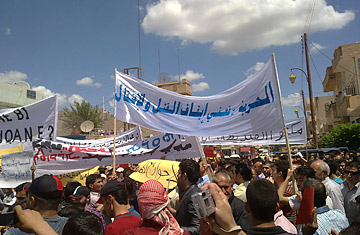
In this photograph, taken by a citizen journalist, antigovernment protesters attend a demonstration in the northeastern city of Qamishli on May 13
Abu Ibrahim, a stocky, bespectacled Syrian from the besieged southern city of Dara'a, bounded into the general store on the Jordan-Syria border in his white plastic sandals, grasping his daughter Noor's hand as the 6-year-old struggled to keep up. He'd left Dara'a, the center of a two-month-old antigovernment uprising, just a few hours earlier and was desperate to get back before the end of Friday midday prayers — and the start of the weekly nationwide protests that have always followed. "I left because we need to find food," he said in a hurried tone. "We've all been sharing what we have with our neighbors, but now we're starving. They have starved us."
It was the first time that Abu Ibrahim, who did not want his full name published, said that he'd dared to venture out in the 18 days since Syrian security forces cordoned off the city and used tanks, snipers and gunfire in a bid to pummel its people into submission. Dara'a is about 11 kilometers from Jordan's Jaber border crossing in the north, which has remained open despite the fact that the larger, nearby Ramtha transit point — just a few kilometers from Dara'a — was sealed on April 25 by Syrian authorities. "It's now a village of only women and children. The men are gone — slaughtered or detained," Abu Ibrahim said of his hometown. "They want to eliminate us, the Sunnis." The city — or rather half of it — was without electricity and water. He claimed that there were incentives to collaborate with the regime, alleging that the Mahata neighborhood (less than a kilometer from his home) had "surrendered" and was rewarded with restored electricity and water.
In the past few weeks, the Syrian protest movement has morphed from a ripple cautiously calling on President Bashar al-Assad to undertake reforms to a wave of nationwide anger demanding the overthrow of Assad and a decades-old regime stacked with loyalists from his minority Alawite community, which makes up about 12% of Syria's population, which is largely Sunni. The unrest has taken on an increasingly sharp and bitter sectarian tone in what was (at least outwardly) a strictly secular state.
Thousands of protesters once again poured into the streets on Friday, despite a ongoing government crackdown that Syrian human-rights activists say has left anywhere from 680 to 800 people dead — hundreds in the last week alone. The protests are an unprecedented act of defiance for a once apolitical, long-cowed populace afraid to speak against, let alone call for the ouster of, their longtime Ba'athist, Alawite rulers.
At least six demonstrators were killed on Friday, according to reports out of Damascus, despite President Assad's reported call for no violence from security forces. More than 9,500 people have been rounded up, the activists say, in mass arrests that have overstretched prisons and prompted authorities to turn stadiums into makeshift jails.
Syria's Information Minister, Adnan Hassan Mahmoud, told reporters in Damascus that a national dialogue with the opposition would begin within days. Earlier on Friday, the Interior Ministry said that 5,077 people connected "with riots turned themselves in to date," just days before a May 15 amnesty for "those who were misled into participating in or committing unlawful acts," according to the state news agency SANA. They were "released immediately after pledging not to repeat any act that harm security of the homeland and citizens."
